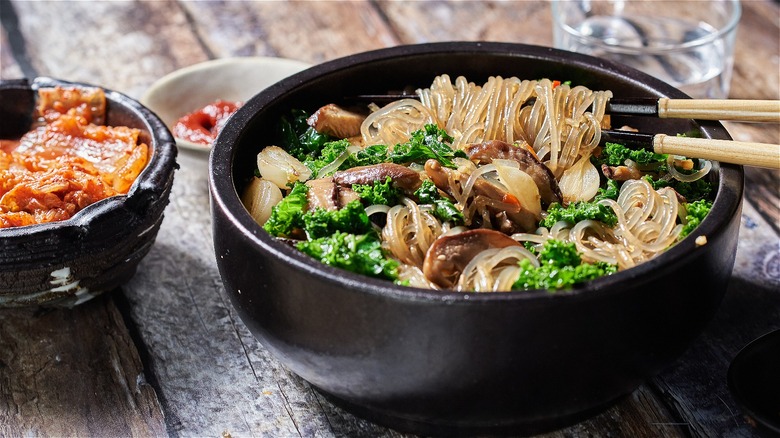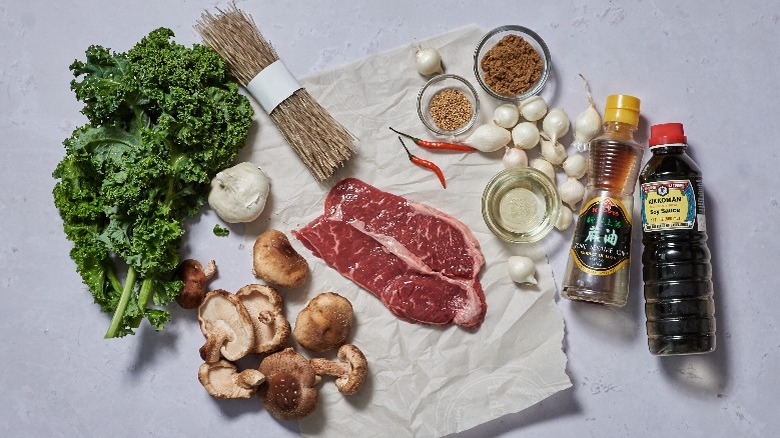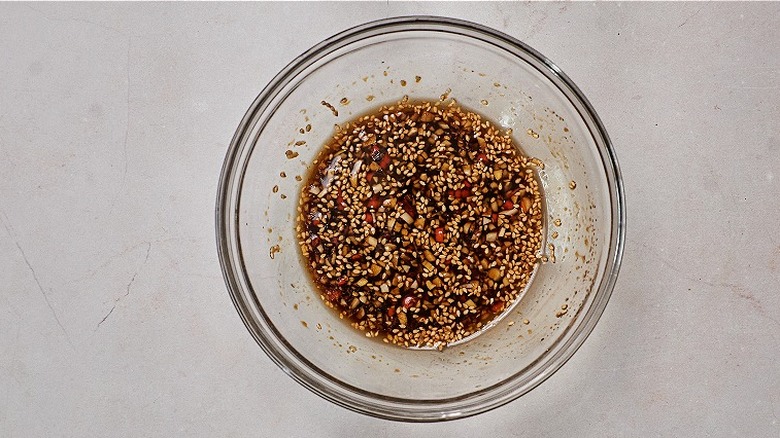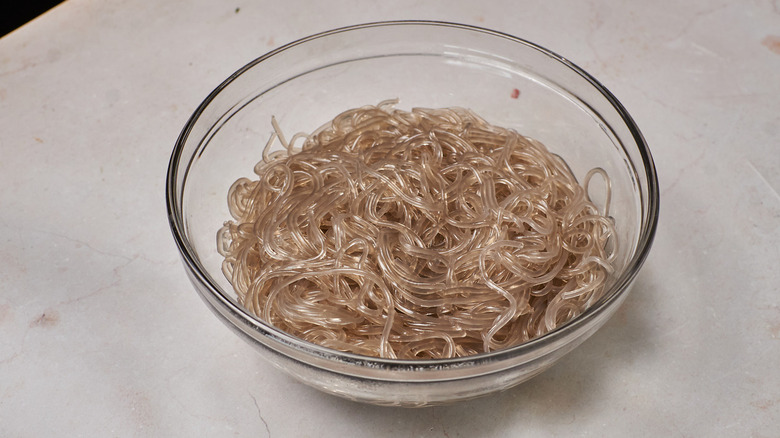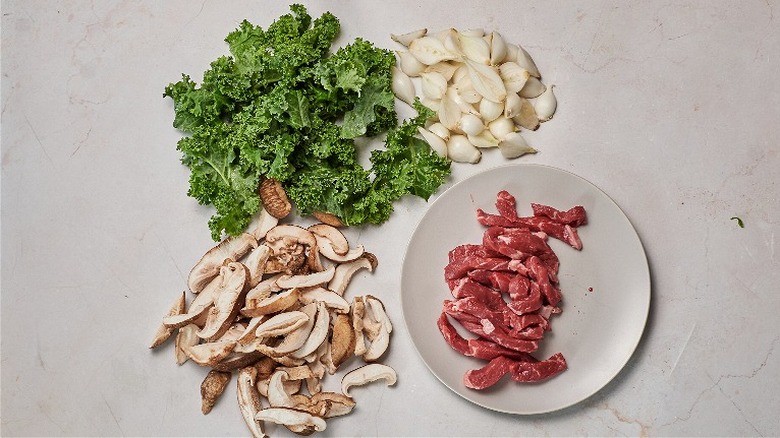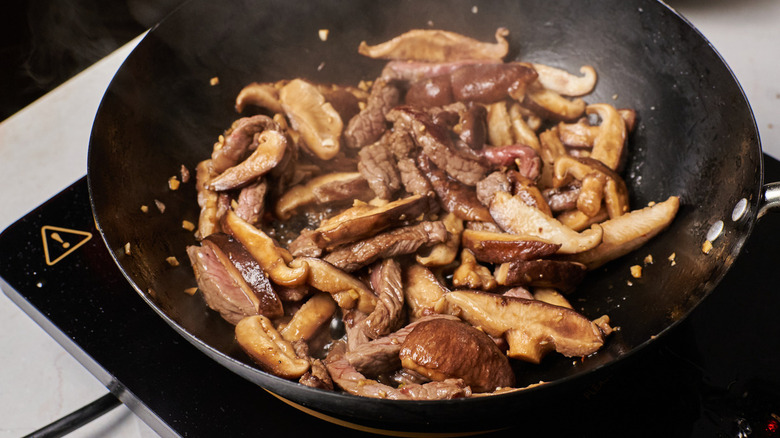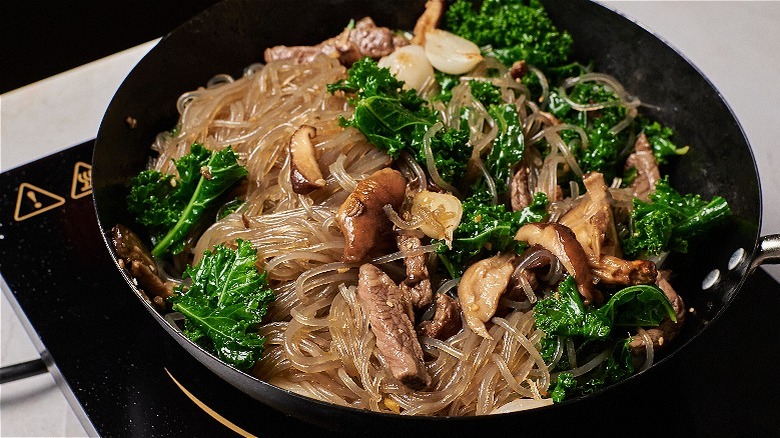Korean Beef Japchae Recipe
Japchae might not be something you see on Western takeout menus very often, but in Korea, japchae is an essential classic dish. Originally reserved for the royals of the Joseon Dynasty, as noted in Korea JoongAng Daily, japchae is now served on special occasions, such as birthdays, as a celebratory dish. The noodle and veggie stir-fry is served alongside other dishes, potluck-style, and acts as an accompaniment to other Korean dishes.
The word japchae translates to mix vegetables, referring to the original dish made up of only stir-fried veggies. Modern versions include noodles and beef but are meant to be vegetable-heavy, with the noodles only complementing the crisp greens. The noodles themselves have become an important part of the dish as well; modern japchae uses bouncy, chewy glass noodles made of sweet potato, a variety not used for many other dishes.
The method of making japchae is also specific. Sue Pressey, the creator of My Korean Kitchen, describes it as "a lot like making bibimbap," which also involves cooking an array of vegetables in separate batches. Sue says this is done to "enhance their natural flavor, texture, and color" and advises against shortcutting the dish into a big stir-fry.
Our beef japchae recipe includes kale, onion, chilies, and mushrooms, but japchae is versatile and can use any assortment of vegetables. Whether you add peppers or swap spinach for kale, you can follow the method below for a perfect, flavorful japchae.
The ingredients needed for Korean beef japchae
Typical japchae requires 4-5 vegetables with various colors and textures. In this recipe, we use green kale, shiitake mushrooms, pearl onions, and chopped chilies, but you can add things like carrots, red bell pepper, spinach, scallions, oyster mushrooms, or even radishes. We also include beef in our recipe. For the beef, choose a thin cut of sirloin and slice it into strips. (If your butcher sells pre-sliced stir-fry beef, you can buy that instead.)
For the sauce, you'll need soy sauce, brown sugar, garlic, sesame oil, and sesame seeds. To stir-fry the vegetables, use vegetable oil, canola oil, or your favorite neutral-flavored oil to keep the wok greased between batches.
Most importantly, you will need glass noodles. While japchae can be made with any thin noodle, it is traditional to use glass noodles made with sweet potato starch. These noodles are springy, with a distinct chew and subtle earthy flavor. If you can't find any at your local grocery store (they will be near the rice noodles and ramen), try your local Asian market. The noodles are grayish in color, transparent, and usually sold in small bundles.
Whisk together the sauce
As with many stir-fry dishes, it is important to prep everything before even touching the wok. Start with the sauce, whisking together the soy sauce, sugar, garlic, sesame, chilies, and sesame seeds, then setting aside. This makes a little over ¼ cup of sauce, which lightly coats the vegetables and adds a savory flavor. For a saucier japchae, consider doubling the sauce recipe.
Prepare the noodles
It's common when making pasta dishes to boil the pasta while the sauce cooks, then drain the pasta right before adding it to the sauce. Stir-fried noodles are a little different, and unless you are very good at multitasking, the noodles should be made in advance. Unless your package says otherwise (some may suggest softening the noodles in warm water), it's best to boil the noodles until al dente, then take them out of the water using tongs. Set them aside — if you're making them more than 10 minutes in advance, toss the noodles in oil to prevent them from sticking.
Prep the vegetables
To save time, use the same water you cooked the noodles in to blanch the kale. Bring the water back to a boil and prepare a bowl of ice water to sit beside it. Drop in the kale (or spinach, if using) and boil until the kale turns bright green, about 10-20 seconds. Remove the kale from the boiling water and plunge it into the ice bath. Blanching the kale may feel tedious, but is a necessary step to keep the greens bright and crunchy.
With the sauce made, the noodles cooked, and the kale blanched, you are almost ready to cook — there's just one more step: Chop the mushrooms, kale, and onions and have them ready beside the wok. Don't try to chop while you cook (tempting, we know), as stir-fry is a very fast process.
Cook the japchae
Since cooking japchae is much like cooking bibimbap, having a precise cooking order will help you cook efficiently. Start with the noodles, then the onions, then the steak and mushrooms. If you are adding any other vegetables, cook them after the onions and before the steak.
For each item, toss them in the wok for only as long as it takes to slightly brown. The noodles will crisp slightly, turning brown as you cook. Remove from the wok when you see color, then add the onions. Toss until browned (pearl and bulb onions will brown nicely on the cut sides), then remove. Add the steak and mushrooms and cook until just browned, glossy, and tender. Keep these in the skillet and add everything back in, tossing with the sauce until warmed through, then remove from the heat. Being precise is important here — japchae is meant to have fresh and crunchy textures.
Serve your japchae
Japchae is often served as a side dish, much like how dim sum noodles are served. While there are plenty of noodles in japchae, it is meant to be a vegetable dish, served alongside other filling foods like bulgogi and tteok dishes. If you plan to serve your japchae as a main, you could accompany it with kimchi, spicy cucumber salad, and an egg garnish.
Japchae reheats well, though it is often served cold and can be enjoyed at any temperature. This makes it perfect for saving leftovers or preparing for meal prep, as it can be eaten even without a microwave handy.
Korean Beef Japchae Recipe
With noodles, beef, a variety of veggies, and a savory sauce, Korean japchae allows you to get a little bit of everything in each bite.
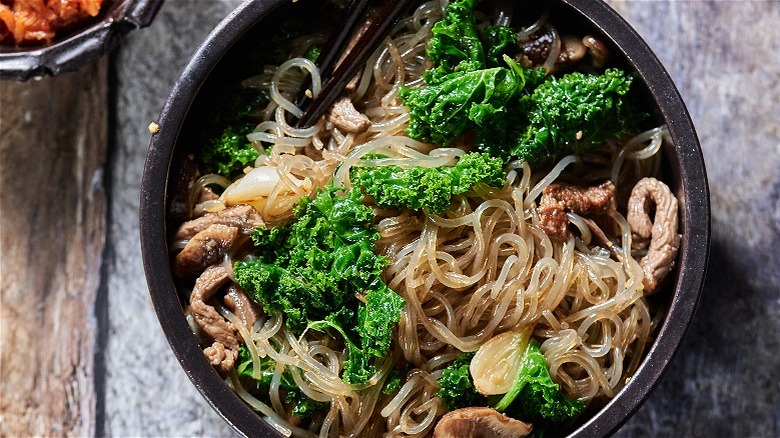
Ingredients
- 4 tablespoons soy sauce
- 2 tablespoons brown sugar
- 1 clove garlic, grated
- 2 teaspoons sesame oil
- 1 teaspoon sesame seeds
- 2 Thai chilies, finely chopped
- 6 ounces sweet potato glass noodles
- 2 packed cups kale, roughly torn, stems removed
- Canola oil, for cooking
- 4 ounces pearl onions, halved and peeled
- ½ pound thinly sliced sirloin
- 4 ounces shiitake mushrooms, sliced
Directions
- Whisk together the soy sauce, brown sugar, garlic, sesame oil, sesame seeds, and chilies until well combined.
- Cook noodles according to package directions until al dente, about 6-10 minutes, depending on the brand. Remove from the water and set aside.
- Bring the water back to a boil and blanch the kale. Once the kale turns bright green, about 20 seconds, remove from the hot water and transfer to an ice bath. Drain and set aside.
- Heat a wok over medium heat. Add the noodles and toss with canola oil until glossy and slick. Noodles will brown slightly. Remove from the skillet and reserve.
- Add the onions to the skillet, adding more oil if needed. Sauté until just browned, about 3-4 minutes. Remove from the skillet and reserve with the noodles.
- Add the steak and mushrooms to the wok with 1 tablespoon of prepared sauce. Toss while the steak browns to coat with sauce. Cook until steak is browned and mushrooms are brown and glossy, about 5 minutes.
- Return the noodles and onions to the wok and add the kale. Add the remaining sauce mixture and toss well to combine. Heat through, incorporating the noodles into the vegetables. Serve warm.
Nutrition
| Calories per Serving | 376 |
| Total Fat | 14.0 g |
| Saturated Fat | 3.9 g |
| Trans Fat | 0.0 g |
| Cholesterol | 44.2 mg |
| Total Carbohydrates | 45.0 g |
| Dietary Fiber | 2.6 g |
| Total Sugars | 6.6 g |
| Sodium | 995.7 mg |
| Protein | 16.6 g |
